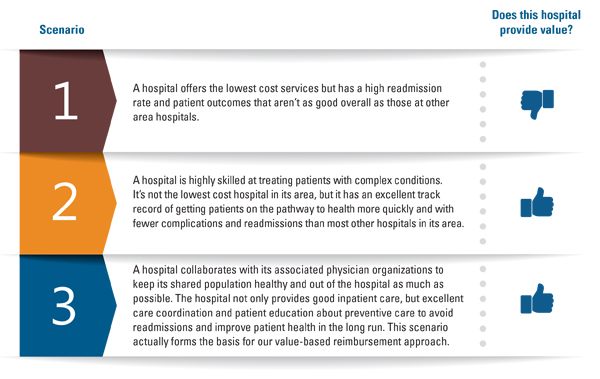|
January – February 2019
A message from Steve Anderson
Building an agreed-upon definition of value
 What is value? What is value?
The term is used a lot, but when it comes to health care, arriving at an agreed-upon definition of value can be difficult. Many different stakeholders — doctors, hospitals, patients, employers and health care plans — have differing visions of what constitutes value in health care. What’s more, they often have conflicting goals, needs and expectations.
That’s not surprising, since health care is an inexact science. It’s complicated by patients with myriad needs and varying outcomes. The needs of an 11-year-old boy with a broken arm, for example, are very different from the needs of a 60-year-old man with multiple chronic conditions and poor lifestyle choices. The time, cost and complexity of treating both all factor into the value equation.
So how does Blue Cross Blue Shield of Michigan define value? Let’s start by putting it in the simplest possible terms:
A year-over-year decrease in cost and increase in quality outcomes, due to effective collaboration between hospitals and physicians.
While the performance-based metrics we use vary from hospital to hospital, some constants remain:
- Cost of care per member per month year over year that outperforms the statewide average
- Reduction in all-cause readmission rates
- Reduction in primary care-sensitive emergency room admission rates
- Reduction in ambulatory care-sensitive admission rates
- Reduction in surgical and procedural complication rates
Generally speaking — and I realize this is a generalization — when costs go down, it suggests that providers are working more collaboratively to better manage a shared population of patients. In simplest terms, if that 60-year-old man I mentioned earlier is seeing his primary care doctor regularly, he’s less likely to need multiple emergency room visits throughout the year. And, of course, an ER is one of the most costly sites of care.
We all recognize that higher cost doesn’t always equate to better outcomes. Here are three scenarios that point to the complexity of measuring value based on cost:

This overview of how we look at value may seem like an oversimplification, but we believe the foundation is solid. We have confidence in the metrics we’ve developed to measure whether a provider is delivering high-quality, low-cost services — in essence, value for our members and group customers.
Our group customers, who provide health care insurance for their employees, are demanding that we take swifter action to make health care more affordable, and our Value-Based Contracting program is our best effort to do just that. We welcome your thoughts as we continue our efforts to evolve a definition of value that everyone can agree on.
Is the definition of value I’ve put forth in this column missing a key element that you think we need to address or does it capture the meaning as you understand it? Please send your thoughts to my colleague, S. George Kipa, M.D., deputy chief medical officer, at GKipa@bcbsm.com.
It’s only by working together that we can all achieve the one goal I know we all agree on: lowering health care costs for everyone in Michigan.
Steve Anderson is vice president of Hospital Contracting & Network Administration with Blue Cross Blue Shield of Michigan. |


 What is value?
What is value?